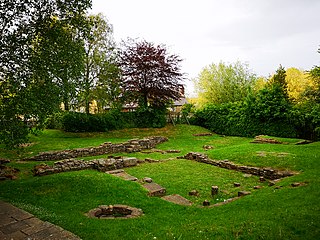
Ceredigion is a large rural county in West Wales. It has a long coastline of Cardigan Bay to the west and the remote moorland of the Cambrian Mountains in the east, with the mountainous terrain of Plynlimon in the northeast. Ceredigion has a total of 264 scheduled monuments. That is too many to have on a single list page, so for convenience the list is divided into two, 163 prehistoric sites and 101 Roman, Medieval and Post Medieval sites.

Hollingbury Castle, also known as Hollingbury Camp and Hollingbury Hillfort, is an Iron Age hillfort on the northern edge of Brighton, in East Sussex, England. It is adjacent to Hollingbury Park Golf Course.

This is a list of scheduled monuments in the English county of Lancashire.
This is a list of scheduled monuments in Staffordshire, a county in England.
This is a list of scheduled monuments in the district of South Derbyshire in the English county of Derbyshire.
There are 121 scheduled monuments in the county of Buckinghamshire, in England. These protected sites date from the Neolithic period in some cases and include barrows, moated sites, ruined abbeys, Iron Age hillforts, a medieval hospital and a holy well. In the United Kingdom, the scheduling of monuments was first initiated to ensure the preservation of "nationally important" archaeological sites or historic buildings. Protection is given to scheduled monuments under the Ancient Monuments and Archaeological Areas Act 1979.
There are 1274 scheduled monuments in the county of Cumbria, in North West England. These protected sites date from the Neolithic period and include barrows, stone circles, Roman forts, standing stones, 19th century industrial sites, abbeys, and ruined castles. In the United Kingdom, the scheduling of monuments was first initiated to ensure the preservation of "nationally important" archaeological sites or historic buildings. Protection is given to scheduled monuments under the Ancient Monuments and Archaeological Areas Act 1979.
There are 425 scheduled monuments in the county of Essex, England. These protected sites date from the Neolithic period in some cases and include barrows, moated sites, ruined abbeys, castles, and a windmill. In the United Kingdom, the scheduling of monuments was first initiated to ensure the preservation of "nationally important" archaeological sites or historic buildings. Protection given to scheduled monuments under the Ancient Monuments and Archaeological Areas Act 1979.
There are 221 scheduled monuments in the county of Northamptonshire, England. These protected sites date in some cases from the Neolithic period and include barrows, artillery forts, ruined abbeys, castles, and Iron Age hill forts. In the United Kingdom, the scheduling of monuments was first initiated to ensure the preservation of "nationally important" archaeological sites or historic buildings. Protection is given to scheduled monuments under the Ancient Monuments and Archaeological Areas Act 1979.
There are 689 scheduled monuments in the county of Kent, England. These protected sites date in some cases from the Neolithic period, and include barrows, artillery forts, ruined abbeys, castles, and Iron Age hill forts. In the United Kingdom, the scheduling of monuments was first initiated to ensure the preservation of "nationally important" archaeological sites and historic buildings. Protection is given to scheduled monuments under the Ancient Monuments and Archaeological Areas Act 1979.
There are 912 scheduled monuments in the county of West Sussex, England. These protected sites date in some cases from the Neolithic period, and include medieval moated sites, ruined abbeys, castles, and Iron Age hillforts. In the United Kingdom, the scheduling of monuments was first initiated to ensure the preservation of "nationally important" archaeological sites and historic buildings. Protection is given to scheduled monuments under the Ancient Monuments and Archaeological Areas Act 1979.












